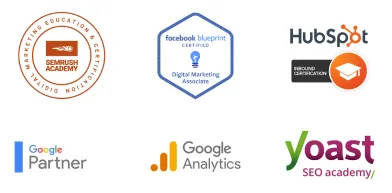TO LEARN IS TO GROW
Learning Center
We do our research and publish our results. Should probably call this the Growing Center.


ADA Compliant Website: Why You Need One
An ADA-compliant website is one that is accessible to people with disabilities, including those who are blind or visually impaired, deaf or hard of hearing, and have mobility or cognitive impairments. These websites follow guidelines and standards set by the Americans with Disabilities Act (ADA) to ensure that they can be used by all visitors, regardless of their abilities.
But why is website accessibility so important? Well, not only does it provide equal access to all users, but it also shows that a business is committed to social responsibility and inclusivity. Plus, with Title III of the ADA applying to businesses, providing equal access to individuals with disabilities is actually a legal requirement. This includes making reasonable accommodations to ensure that their websites are accessible to all visitors.
In recent years, the ADA has been interpreted to include websites as places of public accommodation, increasing the importance of website accessibility for businesses. So, in this article, we’ll be discussing what an ADA-compliant website is, why it’s important, and how your business can achieve compliance.
The History and Purpose of the Americans with Disabilities Act (ADA)
The Americans with Disabilities Act (ADA) is a federal law enacted in 1990 to protect individuals with disabilities from discrimination in various aspects of daily life, such as employment, public accommodations, and telecommunications. The ADA was put in place to ensure that people with disabilities have equal opportunities and access to the same services and activities as everyone else.
The ADA has five sections, also known as titles, that cover different areas of disability rights. Title III of the ADA specifically applies to businesses, requiring them to provide equal access to individuals with disabilities in their goods, services, and facilities. This includes websites, as courts have ruled that websites are subject to the ADA and must be accessible to people with disabilities. Failure to comply with ADA regulations can lead to legal risks and lawsuits, which is why businesses must prioritize website accessibility and ADA compliance.
To achieve ADA compliance, businesses must ensure that their websites are accessible to individuals with disabilities, including those who use assistive technologies like screen readers or braille displays. The Web Content Accessibility Guidelines (WCAG) 2.1, released by the World Wide Web Consortium (W3C) in 2018, provide technical standards and recommendations for website accessibility. While these guidelines are not legally binding, they are widely accepted as the industry standard for website accessibility.
What Does Website Accessibility Mean?
Website accessibility means creating websites that everyone can use, regardless of their abilities or the device they’re using. An accessible website is easy to navigate and understand, and it provides equal access to information for all users.
Different types of disabilities can impact how people use websites. For example, people who are blind or have low vision might use screen readers or magnifiers to access website content, while those who are deaf or hard of hearing might need captions or transcripts to access audio content. People with physical impairments might use assistive devices like keyboard-only navigation, while those with cognitive impairments might need clear and simple language and well-organized content to navigate websites effectively.
There are many common barriers to website accessibility that can make it difficult for people with disabilities to use websites. For instance, images without alt text, videos without captions, small or low-contrast text, and inaccessible navigation menus can all create challenges for individuals with disabilities. To make sure that their websites are accessible, businesses need to identify and address these barriers by implementing design and development best practices.
What is an ADA-Compliant Website?
To be considered ADA-compliant, a website must meet specific technical requirements to ensure accessibility for people with disabilities. The most commonly used set of guidelines for achieving website accessibility is the Web Content Accessibility Guidelines (WCAG), which provide a framework for creating accessible web content.
WCAG is a set of technical guidelines developed by the World Wide Web Consortium (W3C) that are used to ensure that websites are accessible to individuals with disabilities. WCAG 2.1 is the latest version of these guidelines, and it includes three levels of compliance: A, AA, and AAA. For ADA compliance, Level AA is the standard that businesses must meet to ensure that their websites are accessible to individuals with disabilities.
To comply with WCAG 2.1 Level AA standards, websites must include various accessibility features, such as:
text alternatives for images
captions for videos
descriptive labels for form elements
clear and consistent navigation
well-organized content
can be operated with keyboard-only input
There are many website design elements that can improve accessibility and help businesses achieve ADA compliance. For example, using high-contrast colors, providing text alternatives for images, and making sure that links are descriptive can all improve accessibility for individuals with visual impairments. In addition, using clear and simple language, organizing content in a logical manner, and providing easy-to-use forms can improve accessibility for individuals with cognitive and physical impairments.
Why You Should Have an ADA-Compliant Website
An ADA-compliant website can bring numerous benefits for businesses and their customers. Here are some of the key benefits of having an ADA-compliant website:
To improve user experience for people with disabilities
An ADA-compliant website ensures that people with disabilities can access and use your website with ease. This improves the overall user experience for these individuals, making it easier for them to interact with your business and access its products or services.
To increase reach and customer base
By having an ADA-compliant website, businesses can reach a larger audience, including individuals with disabilities. This can expand their customer base and potentially increase revenue.
To mitigate legal risks and potential lawsuits
With the recent legal developments related to website accessibility, having an ADA-compliant website can help businesses avoid legal risks and potential lawsuits. This can save them time, money, and reputation damage.
To improve your brand reputation and social responsibility
An ADA-compliant website demonstrates a commitment to social responsibility and inclusivity. This can improve brand reputation and customer loyalty, as customers appreciate businesses that prioritize accessibility and diversity.
How to Make Sure Your Website is ADA-Compliant
Achieving ADA compliance for your website requires a few specific steps to ensure accessibility for individuals with disabilities. Here’s how to make your website ADA-compliant:
1. Conduct an accessibility audit
You must conduct an accessibility audit of your website to identify any accessibility barriers or issues that need to be addressed. An accessibility audit can help you understand where your website stands in terms of accessibility and identify areas for improvement.
2. Develop an accessibility plan
Once you’ve identified your accessibility issues, the next step is to develop an accessibility plan that outlines specific goals, timelines, and strategies for achieving ADA compliance. The accessibility plan should address issues identified in the accessibility audit and provide a roadmap for making the necessary changes.
3. Implement website accessibility features
Start putting in website accessibility features, such as alternative text for images, captions for videos, and descriptive labels for form fields. Accessibility features should be added to all aspects of your website, including content, design, and functionality.
4. Test and maintain accessibility
After you’ve implemented accessibility features, make sure that you test your website regularly for accessibility and make any necessary changes. This can help ensure ongoing compliance with ADA guidelines and maintain website accessibility over time.
Don't Wait – Make Your Website ADA-Compliant Now with LOJO Marketing!
In today’s digital age, website accessibility is more important than ever before. Ensuring equal access for all users, including those with disabilities, is not only a legal requirement but also a moral imperative for businesses.
Therefore, businesses must prioritize website accessibility and take the necessary steps to achieve ADA compliance. This includes conducting an accessibility audit, developing an accessibility plan, implementing website accessibility features, and regularly testing and maintaining accessibility.
At LOJO Marketing, we understand how important website accessibility is for businesses, which is why just last year, we partnered with Access A Pal, a powerful AI software that can help you achieve ADA and WCAG compliance. It provides amazing features like text-to-speech functionality, magnification, color contrast adjustment, keyboard shortcuts to improve navigation, and so much more!
On that note, we are thrilled to offer a limited-time promotion that slashes the $150 fee for setting up Access A Pal on your website. This offer ends on June 15, so hurry and act now to take advantage of this one-time opportunity!
If you have any questions, you can schedule a FREE consultation with us so that you can start taking the necessary steps to make your website ADA-compliant. Partner with us today and use Access A Pal to achieve accessibility compliance and protect your business from any potential legal issues.

ADA Compliant Website: Why You Need One
An ADA-compliant website is one that is accessible to people with disabilities, including those who are blind or visually impaired, deaf or hard of hearing, and have mobility or cognitive impairments. These websites follow guidelines and standards set by the Americans with Disabilities Act (ADA) to ensure that they can be used by all visitors, regardless of their abilities.
But why is website accessibility so important? Well, not only does it provide equal access to all users, but it also shows that a business is committed to social responsibility and inclusivity. Plus, with Title III of the ADA applying to businesses, providing equal access to individuals with disabilities is actually a legal requirement. This includes making reasonable accommodations to ensure that their websites are accessible to all visitors.
In recent years, the ADA has been interpreted to include websites as places of public accommodation, increasing the importance of website accessibility for businesses. So, in this article, we’ll be discussing what an ADA-compliant website is, why it’s important, and how your business can achieve compliance.
The History and Purpose of the Americans with Disabilities Act (ADA)
The Americans with Disabilities Act (ADA) is a federal law enacted in 1990 to protect individuals with disabilities from discrimination in various aspects of daily life, such as employment, public accommodations, and telecommunications. The ADA was put in place to ensure that people with disabilities have equal opportunities and access to the same services and activities as everyone else.
The ADA has five sections, also known as titles, that cover different areas of disability rights. Title III of the ADA specifically applies to businesses, requiring them to provide equal access to individuals with disabilities in their goods, services, and facilities. This includes websites, as courts have ruled that websites are subject to the ADA and must be accessible to people with disabilities. Failure to comply with ADA regulations can lead to legal risks and lawsuits, which is why businesses must prioritize website accessibility and ADA compliance.
To achieve ADA compliance, businesses must ensure that their websites are accessible to individuals with disabilities, including those who use assistive technologies like screen readers or braille displays. The Web Content Accessibility Guidelines (WCAG) 2.1, released by the World Wide Web Consortium (W3C) in 2018, provide technical standards and recommendations for website accessibility. While these guidelines are not legally binding, they are widely accepted as the industry standard for website accessibility.
What Does Website Accessibility Mean?
Website accessibility means creating websites that everyone can use, regardless of their abilities or the device they’re using. An accessible website is easy to navigate and understand, and it provides equal access to information for all users.
Different types of disabilities can impact how people use websites. For example, people who are blind or have low vision might use screen readers or magnifiers to access website content, while those who are deaf or hard of hearing might need captions or transcripts to access audio content. People with physical impairments might use assistive devices like keyboard-only navigation, while those with cognitive impairments might need clear and simple language and well-organized content to navigate websites effectively.
There are many common barriers to website accessibility that can make it difficult for people with disabilities to use websites. For instance, images without alt text, videos without captions, small or low-contrast text, and inaccessible navigation menus can all create challenges for individuals with disabilities. To make sure that their websites are accessible, businesses need to identify and address these barriers by implementing design and development best practices.
What is an ADA-Compliant Website?
To be considered ADA-compliant, a website must meet specific technical requirements to ensure accessibility for people with disabilities. The most commonly used set of guidelines for achieving website accessibility is the Web Content Accessibility Guidelines (WCAG), which provide a framework for creating accessible web content.
WCAG is a set of technical guidelines developed by the World Wide Web Consortium (W3C) that are used to ensure that websites are accessible to individuals with disabilities. WCAG 2.1 is the latest version of these guidelines, and it includes three levels of compliance: A, AA, and AAA. For ADA compliance, Level AA is the standard that businesses must meet to ensure that their websites are accessible to individuals with disabilities.
To comply with WCAG 2.1 Level AA standards, websites must include various accessibility features, such as:
text alternatives for images
captions for videos
descriptive labels for form elements
clear and consistent navigation
well-organized content
can be operated with keyboard-only input
There are many website design elements that can improve accessibility and help businesses achieve ADA compliance. For example, using high-contrast colors, providing text alternatives for images, and making sure that links are descriptive can all improve accessibility for individuals with visual impairments. In addition, using clear and simple language, organizing content in a logical manner, and providing easy-to-use forms can improve accessibility for individuals with cognitive and physical impairments.
Why You Should Have an ADA-Compliant Website
An ADA-compliant website can bring numerous benefits for businesses and their customers. Here are some of the key benefits of having an ADA-compliant website:
To improve user experience for people with disabilities
An ADA-compliant website ensures that people with disabilities can access and use your website with ease. This improves the overall user experience for these individuals, making it easier for them to interact with your business and access its products or services.
To increase reach and customer base
By having an ADA-compliant website, businesses can reach a larger audience, including individuals with disabilities. This can expand their customer base and potentially increase revenue.
To mitigate legal risks and potential lawsuits
With the recent legal developments related to website accessibility, having an ADA-compliant website can help businesses avoid legal risks and potential lawsuits. This can save them time, money, and reputation damage.
To improve your brand reputation and social responsibility
An ADA-compliant website demonstrates a commitment to social responsibility and inclusivity. This can improve brand reputation and customer loyalty, as customers appreciate businesses that prioritize accessibility and diversity.
How to Make Sure Your Website is ADA-Compliant
Achieving ADA compliance for your website requires a few specific steps to ensure accessibility for individuals with disabilities. Here’s how to make your website ADA-compliant:
1. Conduct an accessibility audit
You must conduct an accessibility audit of your website to identify any accessibility barriers or issues that need to be addressed. An accessibility audit can help you understand where your website stands in terms of accessibility and identify areas for improvement.
2. Develop an accessibility plan
Once you’ve identified your accessibility issues, the next step is to develop an accessibility plan that outlines specific goals, timelines, and strategies for achieving ADA compliance. The accessibility plan should address issues identified in the accessibility audit and provide a roadmap for making the necessary changes.
3. Implement website accessibility features
Start putting in website accessibility features, such as alternative text for images, captions for videos, and descriptive labels for form fields. Accessibility features should be added to all aspects of your website, including content, design, and functionality.
4. Test and maintain accessibility
After you’ve implemented accessibility features, make sure that you test your website regularly for accessibility and make any necessary changes. This can help ensure ongoing compliance with ADA guidelines and maintain website accessibility over time.
Don't Wait – Make Your Website ADA-Compliant Now with LOJO Marketing!
In today’s digital age, website accessibility is more important than ever before. Ensuring equal access for all users, including those with disabilities, is not only a legal requirement but also a moral imperative for businesses.
Therefore, businesses must prioritize website accessibility and take the necessary steps to achieve ADA compliance. This includes conducting an accessibility audit, developing an accessibility plan, implementing website accessibility features, and regularly testing and maintaining accessibility.
At LOJO Marketing, we understand how important website accessibility is for businesses, which is why just last year, we partnered with Access A Pal, a powerful AI software that can help you achieve ADA and WCAG compliance. It provides amazing features like text-to-speech functionality, magnification, color contrast adjustment, keyboard shortcuts to improve navigation, and so much more!
On that note, we are thrilled to offer a limited-time promotion that slashes the $150 fee for setting up Access A Pal on your website. This offer ends on June 15, so hurry and act now to take advantage of this one-time opportunity!
If you have any questions, you can schedule a FREE consultation with us so that you can start taking the necessary steps to make your website ADA-compliant. Partner with us today and use Access A Pal to achieve accessibility compliance and protect your business from any potential legal issues.
Growing Businesses Since 2008
We have helped hundreds of businesses just like yours. Working for or along-side of business owner, managers, staff, or even board of directors, LOJO is ready to be an asset to your business.
Our team has been curated through the years for individual skills, personalities, and capabilities. Our clients put their trust in us to help them grow. We are here to do just that.



Growing Businesses Since 2008
We have helped hundreds of businesses just like yours. Working for or along-side of business owner, managers, staff, or even board of directors, LOJO is ready to be an asset to your business.
Our team has been curated through the years for individual skills, personalities, and capabilities. Our clients put their trust in us to help them grow. We are here to do just that.




Matthew Rogers, President
iProspect Check
After spending several months reviewing multiple proposals from several different companies we engaged LOJO to develop a new website that represents our company effectively. We worked initially with Stephen Platte who helped create the scope of the project. Stephen was knowledgeable and always followed up with me on time and as promised.
He "closed the deal" for LOJO with his professionalism, service orientation and easy going approach. Once we signed the contract we were introduced to Jay Kelly who would be the creative lead for LOJO. This was the most challenging part of the project for my company, as there was no shortage of ideas from our side. Jay managed the project flawlessly, and once we had all agreed to the design, Jay introduced us to Eric.
Eric Lay is one of the founders of LOJO. Eric took the design we had developed and brought it to life. We delivered content as quickly as he requested it. Eric kept the project on task and we responded by exceeding every deadline for content. In turn, once provided, literally not a day went by that Eric didn't add the content and take the next step. In just a few weeks we launched our new website. Eric is a pleasure to work with.
His positive attitude and consultative approach really enhanced the experience and made a big difference for us in the outcome of our project. We would welcome you to visit our website to take a look at the quality work of LOJO. We are very pleased with LOJO and look forward to working with them in the future as we pursue an aggressive SEO strategy."
After spending several months reviewing multiple proposals from several different companies we engaged LOJO to develop a new website that represents our company effectively. We worked initially with Stephen Platte who helped create the scope of the project. Stephen was knowledgeable and always followed up with me on time and as promised.
He "closed the deal" for LOJO with his professionalism, service orientation and easy going approach. Once we signed the contract we were introduced to Jay Kelly who would be the creative lead for LOJO. This was the most challenging part of the project for my company, as there was no shortage of ideas from our side. Jay managed the project flawlessly, and once we had all agreed to the design, Jay introduced us to Eric.
Eric Lay is one of the founders of LOJO. Eric took the design we had developed and brought it to life. We delivered content as quickly as he requested it. Eric kept the project on task and we responded by exceeding every deadline for content. In turn, once provided, literally not a day went by that Eric didn't add the content and take the next step. In just a few weeks we launched our new website. Eric is a pleasure to work with.
His positive attitude and consultative approach really enhanced the experience and made a big difference for us in the outcome of our project. We would welcome you to visit our website to take a look at the quality work of LOJO. We are very pleased with LOJO and look forward to working with them in the future as we pursue an aggressive SEO strategy."

Matthew Rogers, President
iProspect Check
The team at LOJO were wonderful to work with. They are well organized and very patient as we worked through our marketing strategy and developed a well thought out and clear action plan at a reasonable price. We will definitely be back for our future campaign needs."

Jon Crosby, Founder
Dazil

